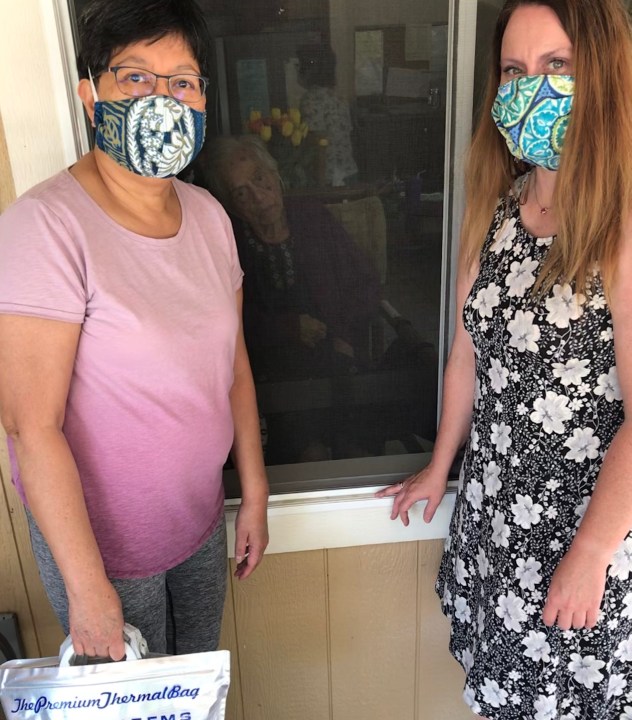AUSTIN (KXAN) — Kim Mathias last saw her mom on Mother’s Day, through the window screen of her assisted living facility.
It was a difficult visit, she said, not being able to be closer, but her 91-year-old mother seemed to be doing alright.

Since then, Mathias got a call letting her know her mom has developed a cough and a “runny nose,” so she’s been quarantined in her room at Tran’s Senior Oasis in Round Rock.
“If this had been another time, they wouldn’t have called to tell me she’s coughing,” Mathias said, explaining her mom is often prone to allergies.
She’s said the care her mom receives at the assisted living facility is excellent, but she’s still been worried about the spread of COVID-19 for months — and is especially worried now.
“My guess is that it is probably allergies, but we don’t know. And of course the first thing I thought…” she trailed off.
Mathias said she would like to get her mom tested, but says taking her out of the facility — which has no confirmed cases of COVID-19 — to a testing site isn’t an option.
“It’s not worth the risk to us right now,” she said.
When Mathias and her husband heard Governor Greg Abbott announce widespread testing for all nursing home residents and staff on Monday, they were hopeful.
“I’ve called the Governor’s office personally,” Dave Mathias said, wanting to know if residents of assisted living facilities will be included in the new testing directive.
But according to an online webinar published by the Texas Health and Human Services Commission, the directive for widespread testing is limited to nursing facilities.
“We’ve gotten a lot of calls about it,” the webinar speaker stated. “I want to make it very clear: that directive was 100% for the nursing facilities. That was not directed at assisted living facilities.”
The speaker went on to say, “However, we all know this situation is evolving on a daily basis, so if that changes, we will certainly share that information with you.”
A spokesperson for HHSC then confirmed to KXAN, “This effort is focused on nursing facilities specifically. Nursing facility residents are among the most at-risk for infection, and the expansion of testing to all residents and staff will provide a full picture of the scope and extent of infection at facilities statewide. The goal is to complete the process of testing nursing facilities within two weeks.”
“My reaction is total disbelief and anger,” Dave said. “I very frankly don’t see a difference here. We are talking about a 91-year-old person, that’s living with five other 91-year-old people, who are people cared for by folks coming in-and-out. Just like nursing homes.”
According to HHSC’s website, a nursing home is defined as: the highest level of care most people will receive outside of a hospital. This type of care is sometimes called custodial care. In additional to a high level of medical care, residents get help getting into and out of bed and with feeding, bathing and dressing and other activities.
Meanwhile, here’s how HHSC describes assisted living: You will usually have your own room or apartment. You can bring your things with you to make it feel like home. You will usually eat with others. Services might include: help bathing or getting dressed, someone to make sure you get your medicine, employees checking on you to make sure you are doing OK.
“I understand the definitions are different, but there’s no difference to me,” Dave said. “I guess my question for Governor Abbott would be, ‘If you had a 91-year-old mother, who was in an assisted living facility with Lewy body [dementia] and other medical conditions, living with five other 90-plus-year-old ladies, would he not consider them at fairly high risk? … Would he not want his mother tested?”
The couple has emailed state health officials and even the White House coronavirus task force, trying to get answers on when assisted living facilities would be tested.
“We’ve gotten no answers,” Kim said.
The Texas Assisted Living Association said testing is happening in some assisted living facilities.
“We’ve been able to work with the state and get those resources to communities with positive cases,” President Diana Martinez said.
She said there is a wider spectrum of care across assisted living facilities, ranging from some who provide medical care to some who just assist residents with daily tasks and prescription management.
“The most frail are in nursing homes,” she explained. “They are there to get ongoing medical, skilled care.”
She said many of their residents in assisted living facility are still vulnerable, but right now less assisted living facilities are seeing outbreaks.
As of Friday, HHSC reported 25.4% of Texas nursing homes with confirmed cases of COVID-19 (311 nursing homes out of 1,224 statewide). Meanwhile, 5.6% of assisted living facilities have confirmed cases (112 assisted living facilities out of 2,004 statewide).
“Our membership has been very lucky that percentage is low right now,” Martinez said. “Many of our members took action very early on to try to implement protocols to try and protect the residents, protect the staff.”
















